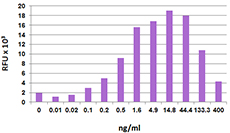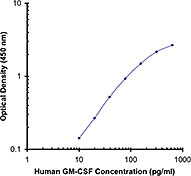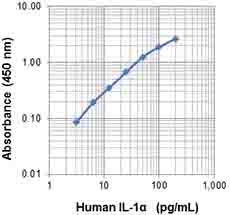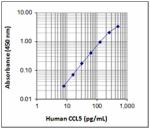- Clone
- Poly5197 (See other available formats)
- Regulatory Status
- RUO
- Other Names
- SIS-delta, T-cell specific protein p288, beta-chemokine RANTES, regulated upon activation, normally T-expressed, and presumably secreted, small inducible cytokine A5
- Isotype
- Goat Polyclonal Ig
- Ave. Rating
- Submit a Review
- Product Citations
- publications

CCL5 (RANTES), also known as CCL5, is a 7.8 kD member of the CC family of chemokines, which is expressed in T cells and monocytes/macrophages. RANTES is strongly chemotactic for monocytes/macrophages, memory T cells, eosinophils, and induces histamine release from basophils. In a solution, RANTES can form high molecular weight aggregates that exhibit dissimilar biological activities to its dimeric form. The aggregates cause T cell and neutrophil activation while promoting HIV infection, whereas the dimeric form exhibits RANTES-induced chemotaxis and inhibits HIV infection. As T cells become activated, RANTES secretion appears to decrease.
Product DetailsProduct Details
- Verified Reactivity
- Human
- Antibody Type
- Polyclonal
- Host Species
- Goat
- Immunogen
- Recombinant human CCL5
- Formulation
- Phosphate-buffered solution, pH 7.2, containing 0.09% sodium azide.
- Preparation
- The antibody was purified by affinity chromatography and conjugated with biotin under optimal conditions.
- Concentration
- 0.5 mg/ml
- Storage & Handling
- The antibody solution should be stored undiluted between 2°C and 8°C. Do not freeze.
- Application
-
ELISA Detection - Quality tested
- Recommended Usage
-
Each lot of this antibody is quality control tested by ELISA assay. For ELISA detection applications, a concentration of 0.25 µg/ml is recommended. To obtain a linear standard curve, serial dilutions of human CCL5 recombinant protein ranging from 500 to 7.8 pg/ml are recommended for each ELISA plate. It is recommended that the reagent be titrated for optimal performance for each application.
- Application Notes
-
ELISA Detection: The biotinylated Poly5197 antibody is useful as the detection antibody in a sandwich ELISA assay, when used in conjunction with the purified antibody J047C5 (Cat. No. 526402) as the capture antibody and recombinant human CCL5 (RANTES) (Cat. No. 580209) as the standard.
Note: For testing human CCL5 in serum, plasma or cell culture supernatant, LEGEND MAX™ Human CCL5 (RANTES) ELISA Kit with Pre-coated Plates (Cat. No. 440807 & 440808) are specially developed and recommended. - RRID
-
AB_2563997 (BioLegend Cat. No. 519703)
Antigen Details
- Distribution
-
RANTES/CCL5 is secreted by lymphocytes, macrophages, eosinophils, platelets, and fibroblasts. RANTES is expressed by hepatocytes, sinusoidal endothelial cells and biliary epithelium during chronic hepatitis C.
- Function
- RANTES can promote IL-2 and IL-5 expression in human T cells, and the expression of IL-6 and IL-8 in fibroblasts from patients with RA. RANTES modulates the LPS-induced IL-6 and TNFα in peripheral blood monocytes; this modulation is through the induction of IL-10 by RANTES.
- Interaction
- RANTES/CCL5 is chemoattractant for memory and activated T cells, monocytes, dendritic cells, eosinophils, NK cells, mast cells, and basophils.
- Ligand/Receptor
- CCR1, CCR3, CCR4, and CCR5.
- Cell Type
- Eosinophils, Fibroblasts, Lymphocytes, Macrophages, Platelets
- Biology Area
- Cell Biology, Immunology, Innate Immunity, Neuroinflammation, Neuroscience
- Molecular Family
- Cytokines/Chemokines
- Antigen References
-
1. Brown KD, et al. 1989. J. Immunol. 142:679.
2. Schall TJ, et al. 1990. Nature 6294:669-671.
3. Cocchi F, et al. 1995. Science 270:1811-1815.
4. Shahrara S, et al. 2006. J. Immunol. 177:5077-5087.
5. Larrubia JR, et al. 2008. World J. Gastroenterol. 14:7149-7159.
6. Gleissner CA, et al. 2008. Arterioscler Thromb. Vasc. Biol. 28:1920-1927.
7. Von Luettichau, et al. 1996. Cytokine 8:89.
8. Schall TJ. 1991. Cytokine. 3:165.
9. Marques RE, et al. 2013. Expert Opin. Ther. Targets 17:1439. - Gene ID
- 6352 View all products for this Gene ID
- UniProt
- View information about CCL5 on UniProt.org
Related FAQs
- How many biotin molecules are per antibody structure?
- We don't routinely measure the number of biotins with our antibody products but the number of biotin molecules range from 3-6 molecules per antibody.
Other Formats
View All CCL5 Reagents Request Custom Conjugation| Description | Clone | Applications |
|---|---|---|
| Biotin anti-human CCL5 (RANTES) | Poly5197 | ELISA Detection |
| Purified anti-human CCL5 (RANTES) | Poly5197 | Direct ELISA |
Customers Also Purchased
Compare Data Across All Formats
This data display is provided for general comparisons between formats.
Your actual data may vary due to variations in samples, target cells, instruments and their settings, staining conditions, and other factors.
If you need assistance with selecting the best format contact our expert technical support team.
-
Biotin anti-human CCL5 (RANTES)
-
Purified anti-human CCL5 (RANTES)

Direct ELISA showing purified anti-human CCL5 (clone Poly519...

















Follow Us